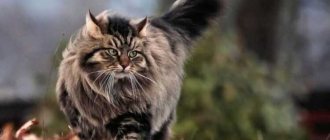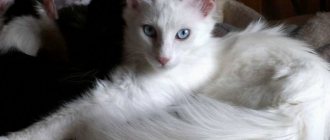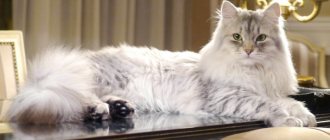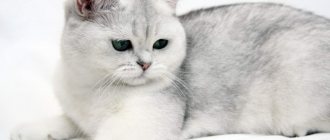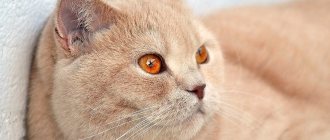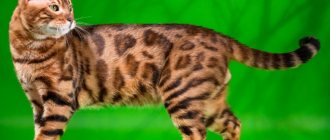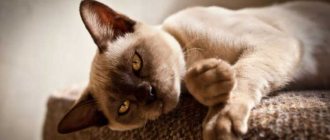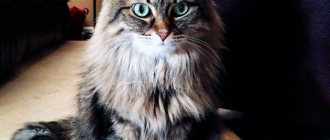Review author: “ZooVita”
Among the 36 breeds recognized by the International Federation of Cat Fanciers, the Russian Siberian cat occupies a worthy place.
Noble appearance, generous character, courage, friendliness - these are the qualities of the breed that attract cat lovers.
History of the origin of the Siberian cat breed
The origin of the Siberian differs from most known breeds. Many of the currently existing cat species were bred after lengthy breeding work. Siberian, according to experts, is the result of natural selection. The cat was brought to the territory of Siberia by pioneers in the 17th-18th centuries.
No one was specifically involved in selection, and felinologists (specialists who study cats) believe that the formation of the breed was significantly influenced by the crossing of local and Persian cats.
A little history
Until recently, the owners of these fluffies did not wonder about the pedigree of their pets, believing that their ancestors came from the Siberian wilderness. At the end of the last century, when clubs for cat lovers were created, they began to find out the history of the origin of Siberians.
Several versions have emerged about the true ancestors of Siberian cats. Their ancestors could have been cats that lived in the Norwegian forests, which were brought to Siberia, and then they spread throughout the entire territory of our Motherland.
- Another version says that they are descendants of Bukhara cats brought by merchants from Asian countries.
- In 1986, metropolitan breeders began to develop a breed standard.
- To do this, they used animals brought by local residents. They wanted to call the breed “Moscow”.
- Afterwards, cats brought from the Siberian hinterlands and the Far East were used.
Already in 1991, the standard for the Siberian breed in Russia was adopted and approved. Five years later, this standard was adopted by the American felinological organization. Today in our country there are several organizations involved in breeding Siberians.
In addition, there are many felinological clubs in different regions of Russia. Siberian felinologists breed cats based on local representatives of the breed.
Interesting facts about the Siberian cat breed
At the end of the 20th century, the current standard was approved, which distinguishes one breed from another. Existing canons of breed interpretation include taking into account the following factors:
- the weight of an elite representative of the species;
- height at withers;
- head shape;
- eye color and shape;
- tail;
- wool;
- general appearance of the physique.
How to choose a kitten and how much does it cost?
It is better to buy an animal from professional breeders. In this case, the new owner will receive documents for the pet - pedigree, veterinary passport, contract. Kittens of the Siberian Masquerade breed are born completely white; points on the coat appear later. Babies are taken from the nursery at three months of age after vaccination.
When buying a kitten, you should make sure that it is healthy. An animal that feels good has a neat, shiny coat, clean eyes and ears. The pet is moderately well-fed, active and good at contact. Characteristic signs of illness are as follows:
- lethargy, depression;
- scratches and bald spots on the body;
- discharge from the eyes and nose;
- dark wax in the ears;
- dirty under the tail;
- unkempt, disheveled fur.
The cost of kittens depends on belonging to a certain class. The most expensive individuals are those that have every chance of participating in exhibitions in the future. These are show-class animals, prices for them start from 35,000 rubles. Kittens with minor defects, but suitable for breeding, cost less - 15,000–25,000. The most inexpensive animals belong to the pet class, these are cats intended only for home keeping. Their estimated cost is 10,000–15,000 rubles.
There are usually 3-4 kittens in a Neva Masquerade litter
Breed standards Siberian cat
According to the standard descriptions of the Siberian cat, its data should be as follows:
- The body weight of an adult animal should reach ten kg.
- Height at the withers is forty centimeters for a male, ten centimeters less for a cat.
- The head is large. It allows the presence of tufts on the ears, which gives the Siberian a resemblance to its wild relative – the lynx.
- The eyes are oval, slightly slanted, and the color is either greenish or yellow.
- Fluffy and moderately long tail.
- A purebred cat must have two undercoats and an outer coat that is impermeable to water. In summer, Siberians look like short-haired breeds; only the tail remains fluffy. With the onset of cold weather, a cute collar appears, and the hind legs are decorated with fluffy “pants.” Well, the tail fluffs up even more.
Appearance
The Siberian cat breed can be described as follows: they have a truly royal appearance and majestic appearance.
Their thick fur makes them look impressive. The strong, large body harmonizes perfectly with the sweet, majestic face.
Siberians have a proportional body:
- A dense body of medium length, a powerful back and a wide chest combine perfectly with a small neck on which an elegant frill flaunts;
- The head is in the form of a trapezoid, the muzzle has smooth outlines. Developed, low-set cheekbones and dense cheeks;
- The ears are medium in size, wide at the base and rounded at the tips. The earlobe has long fur;
- The eyes are medium-sized, oval-shaped, widely spaced. Eye color can be green or yellow;
- Paws are powerful, muscular, of medium length;
- The tail is wide at the base, narrowed and rounded towards the tip;
- The coat is soft, dense undercoat of fine texture. In summer, Siberians have shorter fur than in winter. By the cold season, they develop a rich, thick collar, and their hind legs become more fluffy;
- The weight of males can reach twelve kilograms, females - seven kilograms;
- Height from 28 to 40 centimeters;
- Life expectancy is from 15 to 20 years.
Diseases of the Siberian cat breed
By nature, cats of the Siberian breed have excellent health. Experts believe that only a person with an incorrectly formulated diet and poor care can disrupt the animal’s good health. This is partly true, but at the same time cats can suffer from:
- urolithiasis;
- shortness of breath, lethargy and cough in old age.
In addition, prolonged loneliness can develop extreme excitability and activity in a cat.
Hair getting into the stomach of a pet also causes unpleasant consequences. Typically, a cat gets rid of hairballs using the gag reflex. In some cases, you should help the purr - give a tablespoon of sunflower oil. A teaspoon will be enough for a kitten.
In case of urolithiasis or senile ailments, you should contact a veterinarian.
Buying a kitten
Choosing a kitten is a responsible step, because you are purchasing not just an animal, but a new family member who will become your faithful friend for the next two decades.
A Siberian pet will definitely become a member of your family, so you should take its choice seriously
Some tips:
- Prepare theoretically in advance: try to learn as much as possible about the characteristics of the Siberian breed and the rules for its maintenance.
- “Try on” the cat to your home conditions: think about where he will eat, sleep, go to the toilet, and play.
- Be sure to come to a consensus with all your family on the issue of purchasing a cat - the animal will feel comfortable if it does not bother anyone.
- In a timely manner, select everything necessary for the kitten: bowls for food and water, a tray, a scratching post, combs and toys, stock up on food.
And of course, the most important thing is to decide what kind of kitten, where and why you want to buy. As has already been said, there is nothing wrong with even bringing a cat into your home from the street, much less buying it at a bird market or borrowing it from friends. There are a lot of options - but none of them guarantee that a miracle will happen and thus a truly purebred animal will appear in your home. There is little chance that it will be at least healthy and with a stable nervous system.
A kitten from the street or from friends may differ from the breed standards, even if it looks very similar to a Siberian
How to choose
If you want guarantees, choose a reliable breeder first, and only then a kitten. The choice of nurseries that breed the Siberian breed today is quite large, and they all value their reputation. They will help you choose a child based on his expected prospects and your ambitions.
Remember that a show-class animal can cost several times more than just a pet, which will delight you no less. But if you plan to participate in exhibitions and breeding, then it is better to purchase an older kitten - its qualities can be assessed more accurately. In all other cases, you need to choose a baby no younger than two and a half months - by this age he must be vaccinated and accustomed to at least the basic rules of independent living in a new home.
Do not buy a kitten that is too small - let him grow up a little next to his mother, who will teach the basic rules of cat behavior in the house
If possible, talk to the baby's parents - their appearance and behavior can outline the characteristics of the pet you choose. Listen to the breeder's recommendations - this will help you properly raise a healthy and beautiful animal.
Color of the Siberian cat breed
The photo of Siberian cats shows how different colors breeders do not tempt potential buyers! Among the most popular we note the following:
- tricolor;
- ginger;
- brick;
- golden and silver;
- tortoiseshell;
- two-color;
- the coat has a blue tint, and the nose and paws are gray.
There are several other colors, for example, the gray Siberian cat and the Neva masquerade, but the federation of cat lovers has not yet approved them as a standard.
The color of a kitten's coat is determined by the influence of parental melanin. In nature, there are two types of this substance - black and red. The interaction of colors is the basis for the formation of all existing colors. The exception is the white color of animals.
Character and habits
The Siberian masquerade cat seems stern in appearance, but appearances are deceiving. Those who have already had experience keeping these animals speak of them as gentle, devoted and loving pets. They amazingly combine nobility, calmness and the ability to stand up for themselves.
They fearlessly defend their territory and hunt well, despite the fact that they sometimes seem phlegmatic. However, this does not prevent them from showing patience with children. The Siberian masquerade is not capable of offending a child. Feeling tired from the baby’s excessive attention, she will prefer to go to another room.
The pet is equally attached to all family members, willingly accepts affection, but never imposes its company. Behaves cautiously with strangers. When there are a lot of guests at home, the cat usually goes to a quieter place. The animal knows how to sense a person’s mood and often comes to the rescue when the owner is depressed. The pet rarely gives voice, unless very hungry. He can “keep up the conversation” by responding to the owner’s affectionate remarks.
Siberian masquerade cats can get along with dogs, and in rare cases, with other cats, if they do not claim dominance. Pets raised together perceive each other calmly. What the Nevak will not be able to make friends with is small rodents and birds due to its highly developed hunting instinct.
The hunting instinct does not allow nevaks to live in the same apartment with domestic rodents and birds
Features of behavior of the Siberian cat breed
The character of the Siberian cat is changeable. Siberian beauties love to play with small children, but only if they themselves want to. The lack of reaction to human affection means that the animal is not in a good mood, it is better to leave it alone.
Like all cats, they love to observe everything that happens around them from above. They often climb onto cabinets, shelves, and shelves. Don't be surprised if you find your pet on the chandelier!
It gives the owners undisguised pleasure to watch the amusing poses of their pet.
Important! A cat that lives in a city apartment must be taken for a walk (at least once a week).
Features of care
The rules for caring for a Siberian cat are simple, and if you follow them regularly, your pet will always look great.
Combing
Since the fur of Siberian cats is thick and strong, there are no special problems with caring for it.
It rarely gets into tangles and does not fall out in clumps when shedding. However, it is necessary to take care of it.
It is worth accustoming your pet to the Furminator from a young age, then the animal will be calm during the procedures.
Most of the dead fur ends up in the cat's stomach after washing with the tongue in the morning. To help your pet cope with unnecessary additives, you can add oats or natural grass to the diet.
The Siberian cat is a predator
Siberians should not be bathed frequently, the best option is once every 7-10 months, with the exception of pets who attend regular exhibitions.
But it is also necessary to accustom animals to bath procedures from a young age.
It would also be a good idea to buy or make your own scratching post for your pet .
Walk
Since the character of the Siberian cat breed was formed from the mixing of different types of domestic and wild cats, modern representatives of this species have wild hunting habits.
So that the cat can throw out its accumulated energy and not lose its natural gift as a hunter, it requires regular walks in the fresh air.
It is worth putting a flea and tick collar .
Luxurious red Siberian on a winter walk
At first, you can walk the kitten outside together (if you live in an apartment) or leave your pet for a short time in a limited space in the yard
To do this, you can fence off part of the lawn or place a limiter in a semicircle against the wall.
When the animal gets used to the new place, it will leave for a while for a longer walk, but will definitely return to its home.
Important! Siberians are not afraid of frost due to their thick, dense wool, so they walk well even in severe cold.
Nutrition
Siberian cats eat any food well, from regular human food to special dry mixtures to maintain the shape and appearance of their fur.
Since the fur of cats of the Siberian breed is thick and strong, there are no special problems with caring for it - it rarely gets into tangles and does not fall out in clumps when molting. However, it is still necessary to take care of it
At least sometimes a cat’s diet should include:
- meat;
- fermented milk products;
- goat milk;
- quail eggs.
A complex of vitamins will also not hurt to maintain the color and thickness of the coat.
Conditions for keeping the Siberian cat
Maintaining a furry creature will not require much effort or time. Siberian purrs quickly get used to the tray and are neat and clean. Since cats have rather hard hair, it does not form tangles and does not need frequent brushing. It is enough to brush your fluffy beauty once a week. True, during the spring and autumn molting period the procedure will have to be carried out more often.
The Siberian cat does not like water and should be washed only after a walk in nature. During the water procedure, it is necessary to tightly close the ears with cotton wool, and the water temperature should be in the range of 38-39 degrees.
Considering the strength of Siberians, it is better to wash a cat together. After the “bath”, you need to thoroughly wipe your pet and let it dry in a warm room where there are no drafts.
Important! Regular cleaning of the ears is necessary, and the corners of the eyes should be wiped with a damp cotton swab.
Interesting Facts
Siberians' favorite place to stay in the house is closets and other high places. This is explained by their innate hunting instinct. Climb higher and observe the world around you.
- Siberians perfectly grasp intonation and are able to remember various commands.
- They can even be taught to fetch objects, but due to their natural stubbornness, they will not do it at the first call.
- Therefore, during the learning process they must be encouraged and in no case scolded.
- Representatives of the breed with color point color were identified as a separate breed and called “Neva Masquerade”.
- The warm coat of a Siberian cat not only prevents it from freezing in the cold, but also protects it from rain.
Some representatives of the Siberian breed can be adopted by people who are allergic to cat fur.
Nutrition of the Siberian cat
Cats are not picky when it comes to food, but having an excellent appetite and knowing the weaknesses of their owners, they abuse this and beg from them for various delicacies.
Recommended diet:
- raw lean beef (need to be doused with boiling water);
- poultry meat;
- boiled sea fish;
- dairy products (cottage cheese, cheese, fermented baked milk).
Kittens, nursing mothers and cats expecting offspring benefit from low-fat cream and goat's milk.
As supplements, you can give boiled egg yolk and a minimum amount of dry food of the highest quality.
Many cat lovers accustom their pets to rice, buckwheat and oatmeal porridge.
Proper nutrition and health
Since this cat grows for a long time - up to five years, its diet should be properly balanced and rich in protein. In urban environments, it is advisable to use super-premium dry food with a daily treat in the form of raw chicken meat - heads and necks are suitable.
To avoid the risk of your pet getting intestinal infections, meat should be thoroughly frozen and washed with running water.
Until the age of six months, the kitten is fed five times a day, then transferred to two meals a day.
Cats of this breed were formed as a result of long natural mutations, naturally. Therefore, they do not have genetic or other species-specific diseases.
The few cases of congenital defects in appearance are explained either by a mismatch of parental genotypes or by random factors.
A good appetite, especially in urban conditions, when the cat lacks physical activity, sometimes leads to obesity. You should carefully monitor your pet's diet.
Otherwise, the requirements for maintaining your pet’s health are the same as for other breeds:
- deworming for helminths every three months;
- timely treatment for external parasites, especially important for walking cats;
- Vaccinate annually against rabies and known viral infections.
Interesting features of the Siberian cat breed
- The first mention of Siberian cats dates back to the 16th century. But then they were called Bukhara cats.
- Representatives of this breed are excellent hunters. Having a Siberian cat in the house, you can forget about the existence of any rodents.
- Cats are wonderful fathers and help their “wives” raise their children.
- They are distinguished by monogamous relationships. Cats enter into a “love” relationship with only one cat.
- Siberians are independent and independent creatures. These kinds of pets are suitable for people who do not have the opportunity to devote a lot of time to their pets. Without its owners, the cat will not be bored, but will find something to do to its liking.
- Tortoiseshell males, as a rule, do not give birth to offspring.
- Siberian cats get along well with small children and dogs.
- They recognize only one owner; the rest of the household, at best, are considered only their equals.
- They love boiled shrimp and for the sake of this delicacy they can resort to “blackmail”, refusing to eat other foods.
Choosing a kitten
In order to take a little Siberian into your home, it is better to contact breeders who have proven themselves to be excellent. Since unscrupulous sellers can sell outbred animals, taking advantage of the fact that Siberian cats have a variety of colors.
- The best age to adopt a Siberian cat kitten into your home is three to four months.
- At this age, it is possible to raise a child as needed.
- A six-month-old kitten will have to be retrained, since it has already formed certain habits.
- A three-month-old fluffy should be moderately well-fed and show interest in the world around him. He should not try to escape if picked up.
The baby should have a wide chest, strong paws and shiny fur. The seller is obliged to provide information about vaccinations and pedigree. If the kitten does not have documents, then its price will be no more than three thousand rubles.
A Siberian cat with a pedigree can cost from ten to thirty-five thousand rubles. This price range is explained by the rarity of the animal’s color.
Photo of the Siberian cat breed
Pros and cons of the breed
The Siberian Masquerade cat is highly valued for its many advantages:
- beautiful appearance;
- balanced character;
- devotion;
- tolerance towards children;
- undemanding to the food supply;
- strong immunity.
The disadvantages of the breed include:
- complex grooming;
- the cat’s reluctance to share its territory with other animals.
This breed has many more advantages than disadvantages. The same is confirmed by reviews from owners. The Siberian masquerade cat is an ideal companion with a noble disposition and magnificent appearance, not demanding in terms of living conditions.
How much money do you need for care and maintenance?
What to buy for a kitten
Required set:
- Two or three bowls (depending on the type of feeding). Choose a large water bowl - Siamese often like to drink from large containers. Price: 150 – 320 rub.
- Tray. Large with deep sides: 250 – 1350 rub.
- Wide-toothed comb or brush with natural bristles: RUB 350 – 650.
- Scratching post: 900 – 2500 rub.
- Toys. Choose intellectual ones and those that you can run after. Price: 600 – 3500 rub.
- Plastic carrier with metal door. Price: 1250 – 2600 rub.
- Bed. Warm with sides: 500 – 2000 rubles.
Additional products:
- Vertical game complex. Price: 5000 – 32000 rub.
- Claw cutter. Price: 350 – 590 rub.
- Harness with leash. Price: 850 – 1600 rub.
- Anti-cat bars for windows. Price: 1800-2450 rub.
- Automatic drinking fountain. Some Siamese cats love to drink running water. Price: 1800 – 4800 rub.
The annual care of a Siamese cat may require from 20 to 40 thousand rubles.
The budget will depend on your capabilities, the chosen diet, the type of filler and the health of the pet.
Raising a Siamese cat
A kitten must be raised from the first days of its appearance in the house. If you don’t want to rack your brains over how to stop him from scratching or relieving himself in the wrong place, then immediately stop all prohibited actions. Use standard prohibition commands: “fu” and “no”. The first is used for a permanent ban, the second for a temporary one. For example, “fu” can be used to discourage walking on the dinner table, and “no” can be used to prohibit scratching after sterilization.
Education should be based on affection and respect. Vengeful and aggressive animals are the result of abuse. The main tool of influence is intonation. It is well captured not only by adult animals, but also by kittens.
Siamese are clean, so they are easy to toilet train. Be persistent during training. Do not give up ahead of time, otherwise the pet will understand this and will create the appearance of misunderstanding with your commands.
Looking for a Siamese cat? Find your pet from 1 offer Buy
How much does a Siamese cat cost?
The final price of a Siamese cat includes the prestige of the pedigree, the availability of vaccinations, the fame of the nursery and the class awarded to the kitten. The average cost of pet-class animals is 20 thousand rubles, breed class - 30 thousand rubles, and show class - 50 thousand rubles.
If you don’t have that amount of money, but really want a Siamese cat, then try contacting a shelter. In addition to yard animals, there are also “lost animals” and purebred pets with disabilities. They can be purchased completely free of charge. Despite their difficult fate, they quickly become attached to a person and become full members of the family.
Do you like the article? 0
Health of the Siamese cat
The breed is long-lived. The maximum lifespan of these animals is 20 years. However, the Siamese cat's health can be precarious if its diet is not monitored.
For your pet’s health, do not forget about parasite treatment and vaccinations. Deworming is carried out quarterly, and vaccination is carried out annually. There is a separate vaccination schedule for kittens. From 2-3 months to 1 year, vaccinations are given gradually with mandatory revaccination. After 1 year, animals are administered only polyvalent vaccines containing several viruses simultaneously. They provide immunity against the most common viral diseases.
Possible diseases
It is impossible to protect your pet from all diseases, so do not forget about preventive examinations with a veterinarian. The following diseases are common among representatives of the Siamese breed:
- Bronchial asthma
. If your cat is bothered by frequent and prolonged coughing attacks, get examined. Asthma is often caused by allergens: tobacco, household chemicals, house dust. If the situation is left to chance, the cough can develop into suffocation or respiratory failure. The pet may die. Determining the exact cause of asthma is almost impossible. If there are no pathological changes on the x-ray, the doctor prescribes antihistamine tablets. If the symptoms disappear, the diagnosis is confirmed. For frequent attacks, veterinarians recommend purchasing a cat inhaler.
- Amyloidosis
. When protein metabolism is disrupted, excessive amounts of abnormal proteins accumulate in the liver, kidneys or pancreas. They trigger an autoimmune process - the rejection of their own cells with subsequent destruction of the affected organs. There is no cure for the disease, but it can be slowed down with early diagnosis.
- Pathologies of the cardiovascular system
. This group includes aortic stenosis, accompanied by a decrease in blood supply to the heart. Animals with this disease are culled from breeding. Treatment depends on the severity of the pathology. If the quality of life is not threatened, then it is enough to protect the pet from intense physical activity.
Obesity and joint diseases often avoid Siamese, but this does not mean that the cat can be overfed.
Reproductive health
The first heat in Siamese occurs at 5-9 months, but mating is allowed no earlier than the third heat. With earlier fertilization, the cat is not able to bear healthy kittens. Pregnancy lasts from 55 to 65 days. Vitamins prescribed by a veterinarian must be added to the diet of a pregnant pet. They contribute to the proper formation of embryos and strengthen the mother’s immune system.
Siamese cats give birth to from 4 to 8 kittens, and some record holders give birth to offspring numbering 13 babies. Primiparous females often suffer from a lack of milk. The problem can be solved by injections of medications, but they can only be done after examination by a veterinarian. Dosages calculated independently can harm the animal.
If you are not ready to give birth, sterilize your animals. Spaying and neutering are recommended for all cats not involved in breeding. The optimal age for surgery is 6-8 months. Younger age is fraught with obesity and pathologies of the genitourinary system. Older pets are more difficult to tolerate anesthesia, so surgery is performed only as a last resort.
